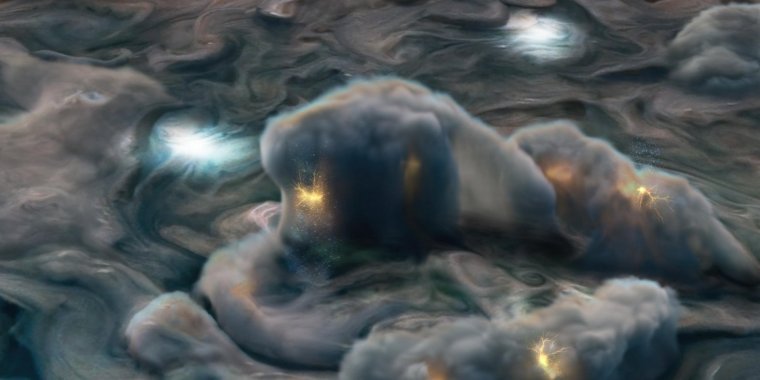| News / Space News |
'Shallow Lightning' and 'Mushballs' Reveal Ammonia to NASA's Juno Scientists
New results from NASA's Juno mission at Jupiter suggest our solar system's largest planet is home to what's called "shallow lightning." An unexpected form of electrical discharge, shallow lightning originates from clouds containing an ammonia-water solution, whereas lightning on Earth originates from water clouds.

This illustration uses data obtained by NASA's Juno mission to depict high-altitude electrical storms on Jupiter. Image Credit: NASA/JPL-Caltech/SwRI/MSSS/Gerald Eichstädt
Other new findings suggest the violent thunderstorms for which the gas giant is known may form slushy ammonia-rich hailstones Juno's science team calls "mushballs"; they theorize that mushballs essentially kidnap ammonia and water in the upper atmosphere and carry them into the depths of Jupiter's atmosphere.
Since NASA's Voyager mission first saw Jovian lightning flashes in 1979, it has been thought that the planet's lightning is similar to Earth's, occurring only in thunderstorms where water exists in all its phases - ice, liquid, and gas.
At Jupiter this would place the storms around 28 to 40 miles (45 to 65 kilometers) below the visible clouds, with temperatures that hover around 32 degrees Fahrenheit (0 degrees Celsius, the temperature at which water freezes).
Voyager saw lightning as bright spots on Jupiter's cloud tops, suggesting that the flashes originated in deep water clouds.But lightning flashes observed on Jupiter's dark side by Juno's Stellar Reference Unit tell a different story.
The team suggest that Jupiter's powerful thunderstorms fling water-ice crystals high up into the planet's atmosphere, over 16 miles (25 kilometers) above Jupiter's water clouds, where they encounter atmospheric ammonia vapor that melts the ice, forming a new ammonia-water solution.
At such lofty altitude, temperatures are below minus 126 degrees Fahrenheit (minus 88 degrees Celsius) - too cold for pure liquid water to exist.
At these altitudes, the ammonia acts like an antifreeze, lowering the melting point of water ice and allowing the formation of a cloud with ammonia-water liquid. In this new state, falling droplets of ammonia-water liquid can collide with the upgoing water-ice crystals and electrify the clouds. This was a big surprise, as ammonia-water clouds do not exist on Earth.
The shallow lightning factors into another puzzle about the inner workings of Jupiter's atmosphere: Juno's Microwave Radiometer instrument discovered that ammonia was depleted - which is to say, missing - from most of Jupiter's atmosphere. Even more puzzling was that the amount of ammonia changes as one moves within Jupiter's atmosphere.
The strange brew of 2/3 water and 1/3 ammonia gas that becomes the seed for Jovian hailstones, it is known as mushballs. Consisting of layers of water-ammonia slush and ice covered by a thicker water-ice crust, mushballs are generated in a similar manner as hail is on Earth - by growing larger as they move up and down through the atmosphere.
Eventually, the mushballs get so big, even the updrafts can't hold them, and they fall deeper into the atmosphere, encountering even warmer temperatures, where they eventually evaporate completely. Their action drags ammonia and water down to deep levels in the planet's atmosphere.
Combining these two results was critical to solving the mystery of Jupiter's missing ammonia. As it turned out, the ammonia isn't actually missing; it is just transported down while in disguise, having cloaked itself by mixing with water.
The solution is very simple and elegant with this theory: When the water and ammonia are in a liquid state, they are invisible to us until they reach a depth where they evaporate - and that is quite deep. (NASA)
YOU MAY ALSO LIKE





